Being among the most desired destinations for travelers, Greece enjoys a strategic location in the Mediterranean Sea. Rich in antiquity treasures and breathtaking landscapes, the country has become a synonym for both cultural and laid-back activities. People fly from all over the world to enjoy carefree and sunny days on the country’s welcoming soil. And if you plan to spend at least one week in Greece, I can assure you that you’ll have a fantastic time.
As a Greek, I traveled extensively around the country. I’ve seen its stunning islands and visited lesser-known locations. Moreover, my hometown, Athens, has slowly transformed into a standalone destination for travelers, offering vibrant local life, beautiful beaches, and antiquity sightseeing. For every itinerary you’ll see below, the base for the first three days is Athens. The Greek capital is one of the most legendary cities of the ancient world and I believe you should see at least parts of it.
That said, I decided to put together this long travel guide to Greece to help you make the most of your vacation. Specifically, due to the country’s diversity, I have created itineraries for your Greek vacation based on different travel styles. While most people will appreciate a mixture of sightseeing and beach time, I’ve split this guide to Greece into three itineraries: a Cultural, dealing with sightseeing, an Island-hopping to make the most of the islands, and a Combo that combines both.
So, if you are wondering how to plan your one-week holiday in Greece, you’re in the right place. In the following lines, you will read lots of local travel tips, find resources and itineraries, and see photos. Apparently, you can stretch these itineraries for a 10-day trip or even if you plan to spend two weeks in Greece.
Let’s start.
*Some of the links are affiliate links. It means that if you buy something, I might earn a small commission at no additional cost to you.
One Week in Greece: Introduction & Resources

If you fly to Greece from abroad, you will probably land in Athens. The Athens International Airport (AIA) is the primary hub of Greece. In former times, Athens didn’t receive that much attention: travelers would land at the airport, and the following day, they were off to the islands. During the years of Greece’s economic crisis, people thought that Athens was a dangerous city that didn’t deserve a visit. However, this was never the case.
Athens is one of the most famous cities of antiquity, where democracy was born, and we owe a big part of Western Civilization to the city’s past. But it’s not just about history. Contemporary Athens is a multiculti city, at the crossroads of East and West, full of subcultures and diversity. Finally, after a decade of social decay, Athens finds its balance again, and it slowly becomes a city to visit. You see, there are just a handful of capitals in Europe where the past is so omnipresent as it is in Athens.
Why am I writing all these? Well, it’s because I want to encourage you to spend at least a part of your one week in Greece in its capital. The guide you will read below offers several itineraries, but as I already stated, every one of them starts from Athens. So, while I tried to compile itineraries and things to do for everyone, all of them included Athens as a must-see.
And I’m sure that you won’t regret spending at least 3 days in Athens.
1 week in Greece resources
Before starting with the breakdown of itineraries for your one-week vacation in Greece, I’m adding some resources. These are always the websites I use before booking a holiday in Greece. They will help you organize your trip to Greece.
Aegean Airlines. This is Greece’s flag carrier. It offers loads of international flights, and it is a Star Alliance Member. Apart from that, you will need their services to book domestic flights in Greece. If you are fond of Business Class traveling, I also wrote a comprehensive review of Aegean’s Business Class. You can book your Aegean Airlines flights here.
Kiwi. If you are traveling to Greece from abroad, KiWi is always the safest choice for booking tickets. You can book your flights with KiWi here.
Booking.com. I will add several hotels and accommodation options in Greece later. But if you want to check your accommodation options in Greece, you can do it via Booking.
RentalCars. This is always where I book a car. The truth is that driving in Greece can sometimes be stressful. While the roads have improved during the last few years, the Greeks are notorious for their driving skills. For example, zebra crossings are still assumed to be street decorations. I will let you know when you need a car for the itineraries below. If that’s the case, RentalCars is the place to book one.
FerriesInGreece. I know that most of you would love to see at least one of the Greek islands. Although you can be spontaneous, I always suggest booking your ferry tickets in advance. I always book mine via FerriesInGreece.
One week in Greece: how to spend 3 days in Athens

Athens is a diverse city, and it definitely deserves a couple of days from your Greek vacation. Of course, if you have no interest in Athens or have visited it previously, you can skip this part.
The city of Athens has existed in the same spot for more than 2,500 years. However, Athens is not just the Parthenon. There are several things to do in Athens, and you can enjoy some charming days there. As I said, I’m using Athens as a basis for your first three days in Greece in this guide. Apart from relaxing from your flight, you will also have a good introduction to Greek culture.
Downtown Athens is the place to stay. You will be close to everything the city offers, and you can walk from place to place. Although the Athens metropolitan area is home to almost four million people, Athens’ city center is compact.
So, let’s break down your 3-day Athens itinerary.
3 days in Athens: Day 1
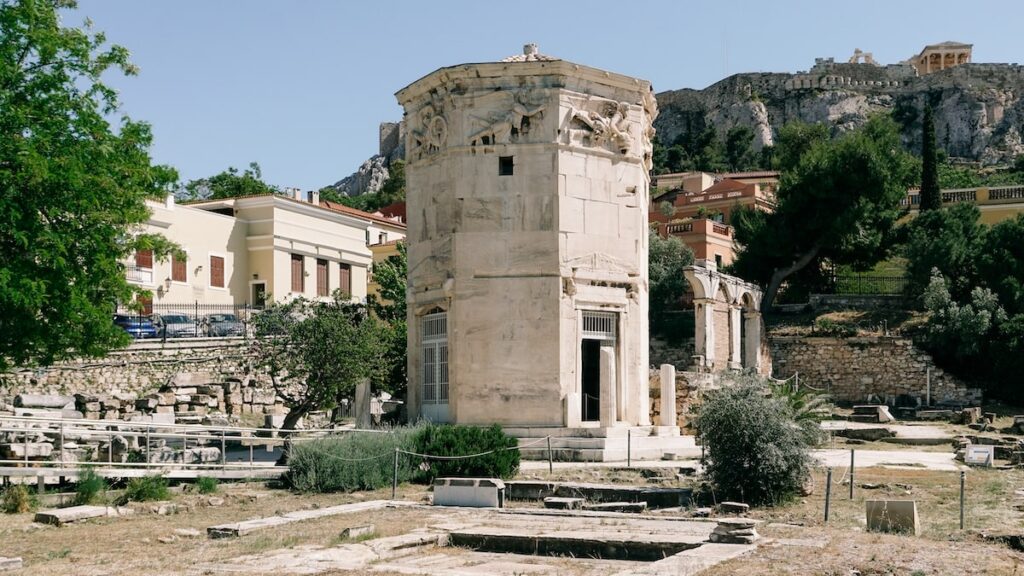
Since I’m a fan of slow traveling, I would take it easy the first day. After landing at the airport, get the blue metro line and head downtown. The metro runs every 30 minutes, and the ticket costs one way 10 euros. You will need approximately 35 minutes to Syntagma Square or Monastiraki, the two stations in Athens’ very heart. Head over to your hotel, check in, and start walking.
For your first day in Athens, I suggest a walk around Plaka. This is the Old Town of Athens, the area where the ancient city once existed. In the late 1980s, Plaka was infamous for criminality and drug dealing, but nowadays, it is one of Athens’s most prestigious areas.
Located straight beneath the Acropolis, Plaka is the most charming area of downtown Athens. You will get a glimpse of the Ancient Agora, the Hadrian’s Gate, and the Tower of the Winds. On the upper end, it’s also Syntagma Square, where you can see the Greek Parliament. Last but not least, while strolling around Plaka, you will always have an Acropolis view!
And here’s a travel tip: Visit Anafiotika, a micro-neighborhood straight beneath the Acropolis. Built over a century ago by the people of the small island of Anafi, Anafiotika looks like an island beneath the Acropolis. Definitely one of the sweetest spots in the city. I have written an extensive guide to Anafiotika; make sure to read it before visiting Athens.
Where to eat and drink the first day in Athens
I would suggest remaining in the Plaka area. An excellent spot for food is Yasemi, especially in the spring/summer, where you can sit outside. Another option is Melina, named after the famous actress and politician Melina Merkouri.
Although Plaka is not the center of Athenian nightlife, it has some beautiful spots. Some of them come with an Acropolis view. Even during the wintertime, you can have some mild nights, and outdoor seating is possible. For a drink or two, I would suggest Couleur Locale, a prime spot close to Monastiraki. The bar is on the fourth floor of an old building (accessible by lift, too), and from there, you can see the Parthenon illuminated. Excellent cocktails.
3 days in Athens: Day 2

Wake up early and make the most out of your day. This is a day for sightseeing, and depending on your interests, there are several things to do in Athens.
The Acropolis and the Parthenon are must-sees. Yes, I know that a visit there is rather expensive. However, if there’s one thing to do in Athens, then this is it. Climb the ancient rock of the Acropolis and see the Parthenon with your eyes. Of all the legendary landmarks of antiquity, this is probably the most legendary one. Acropolis’s ticket costs 20 euros per person, but there is a combo ticket that costs 30 euros and lets you enter every archaeological site in Athens. To avoid long queues, prebook your Acropolis ticket here.
There’s also a wonderful belt road around the Acropolis connecting several places of interest. You can access the neighborhood of Thiseio, but from there, you can also reach the Acropolis Museum (book a skip-the-line ticket here). That’s a relatively new museum (well, compared to Acropolis itself), which opened in 2009 to the public. It receives a lot of attention and loads of advertisements from the Ministry of Culture. It hosts an excellent collection with all you need to know about the Acropolis and the Parthenon, but it somehow overshadows all the other museums in Athens. (After finishing the Athens guide, I will add some museums that deserve a visit. Pick one and visit it after the itinerary mentioned above.)
For the time being, head over to Monastiraki Square, one of the most vibrant areas in downtown Athens. Cross the street and find yourself at Psyrri, one of the nicest neighborhoods in downtown Athens. There are several places to have lunch, all offering decent food and drinks. Walk through its narrow streets, and then head over to Ermou. That’s the shopping artery of Athens, a long pedestrian street full of shops and people.
After reaching Syntagma Square (Syntagma stands for Constitution), you have two options: explore Kolonaki or Exarheia. These are two neighboring areas that don’t have much in common. Kolonaki is the posh neighborhood of Athens, where the local high class (or the wannabees) socialize. It is a charming area that has retained its style through the years. Do expect elevated prices and some local version of snobbiness.
Exarheia, on the other hand, is the alternative hood of Athens, an area where various subcultures gather. Don’t believe the news: the area is 100% safe, although there are some riots from time to time, usually against the police. Imagine it like the Greek version of Sankt Pauli in Hamburg or Kreuzberg in Berlin. An excellent spot to hang out and have lunch or drinks at low prices.
Where to eat and drink the second day in Athens
Since you have already spent some time around Plaka, I suggest having dinner around Exarheia, Kolonaki, or Psyrri. For a drink in the evening, head over to the area around Kolokotroni Street. Drunk Sinatra has a pleasant atmosphere and excellent drinks, and The Clumsies has some award-winning bartenders.
3 Days in Athens: Day 3
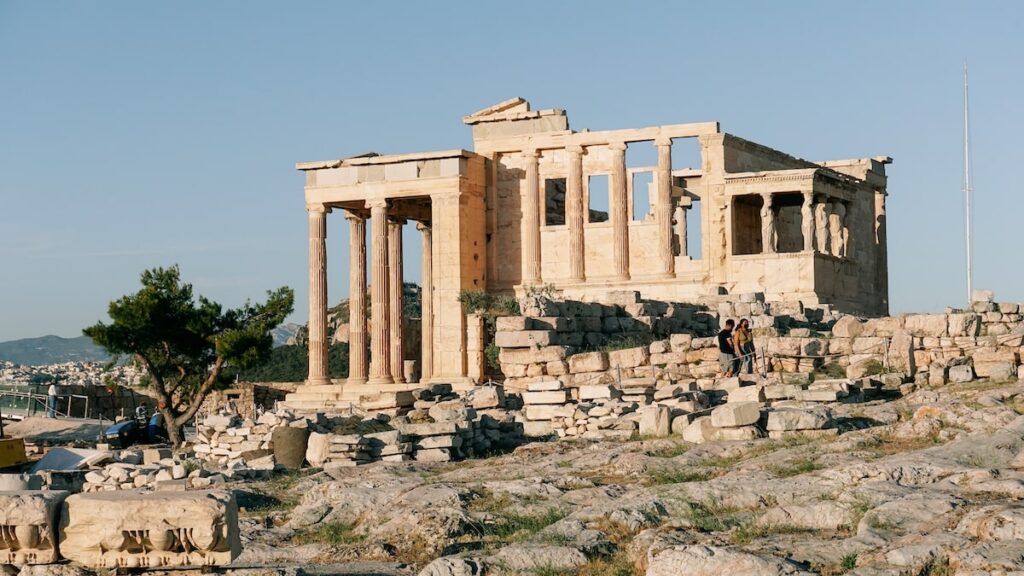
Give yourself a relaxing day, and enjoy your time in Athens. If you haven’t visited the Ancient Agora, give it a try and walk through the ruins. After that, head over to the Temple of Zeus. Although it is also a ruin, try to imagine its size. Despite being in a less prime location than the other landmarks, it’s one of the things to see in Athens. Last but not least, a short walk from the Temple of Zeus will bring you to the Panathenaic Stadium, the so-called Kallimarmaro. The Panathenaic Stadium is where the first modern Olympic games took place in 1896.
Don’t confuse it with the Olympic Stadium of Athens, where the modern Olympic Games of 2004 took place; for that, you’ll need the Green Line of the metro (stop: Eirini). You have probably seen the Olympic Complex both on TV and Instagram. While this is an architectural gem (and an Instagram-able motive, too), the area around it has nothing to offer. Take a stroll around Santiago Calatrava’s Olympic Complex and head over to a nearby neighborhood like Halandri or Maroussi.
Now, for your late lunch downtown, you should try Gazi. This area was named after the Gas Factory in Athens, and it’s one of the most vibrant areas for nightlife. After lunch, visit the Stavros Niarchos Foundation, the new highlight of Athens. In this large complex by architect Renzo Piano, you will find one of Athens’ nicest walks. Featuring modern architecture and a huge park, that’s where the Athenians stroll lately. Adjacent, you will find the National Library and the Opera. There is also an open-air cinema in the park during the summer and loads of events. Don’t miss it.
Where to eat and drink on the third day in Athens
If you want to see something more than downtown Athens, head over to Glyfada and Athens’ southern suburbs. It might be hard to reach it by public transport (it’s possible, but it’ll take time). The tram from Syntagma Square is your best choice here. This is where the big outdoor clubs are. Places like Bolivar host parties every week, and it’s pure joy to be there in the summertime. For food, try the little tavernas at Piraiki, where the fish is always fresh.
Selected Museums in Athens

Although the Acropolis Museum is the most visited by far, Athens has much more to offer. The Museum of Acropolis somehow created a monopoly, and I find this a pity. I’m adding a list of other museums in Athens that deserve a visit. Some of them are located outside the city center, which means that you will also have the opportunity to see other neighborhoods or suburbs of the Greek capital.
- National Archaeological Museum. As the name betrays, that’s the place to see more things from the city’s past. Check the NAM exhibitions here.
- Benaki Museum(s). There are actually multiple venues hosting the Benaki Museums: one at Vasilissis Sofias Street, one at Pireos 138 Street, plus the Museum of Islamic Art. The first one is the oldest, while the other two are relatively new. However, the Benaki Museum at Pireos is a very dynamic establishment, offering top-class exhibitions. You can see what’s in the show at both Benaki Museums here. The one at Vasilissis Sofias Street has a beautiful veranda with a view.
- Goulandris Museum. Located in Kifisia, one of Athens’ traditional high-class suburbs, the Goulandri Museum runs several exhibitions per year. It also features a splendid cafe with outdoor seating. Check the Goulandris Museum exhibitions here.
- Frysira Museum. You can find the Frysira Museum in downtown Plaka. It is a relatively small building but has a significant architectural interest. Built by Ernst Ziller, the Frysira Museum has a handful of carefully curated exhibitions per year. Check out the Frysira Collection here.
- Museum of Cycladic Art. One more excellent museum in downtown Athens, the Museum of Cycladic Art, deals mainly with exhibitions about the ancient cultures of the Aegean and Cyprus. You can easily combine it with the Benaki Museum at Vasilissis Sofias. Check the exhibits of the Museum of Cycladic Art here.
The best hotels in Athens
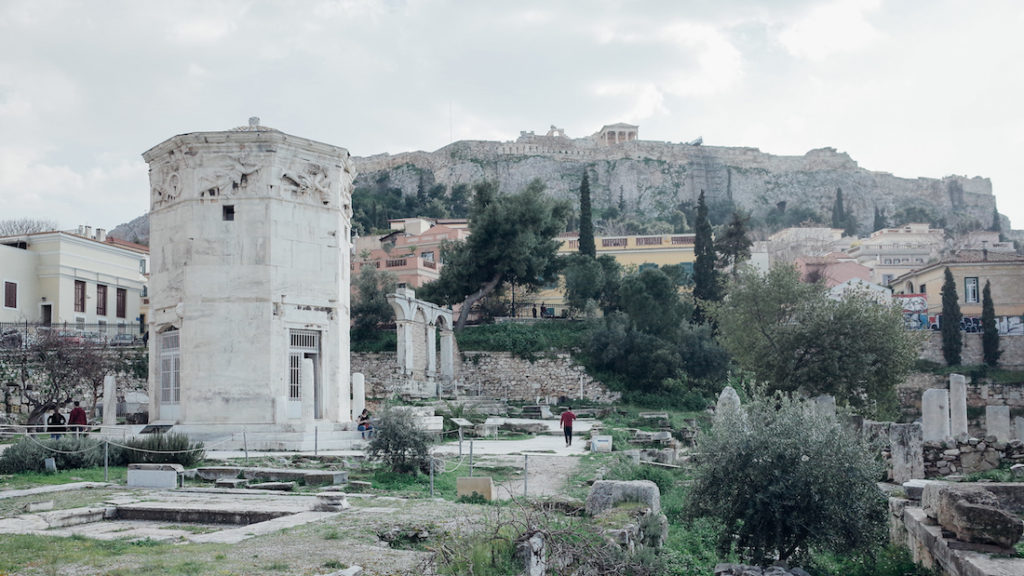
Finding a hotel in a European capital can sometimes be overwhelming -and Athens is not an exception. There are thousands of options for your accommodation in Athens, but I will focus on the ones that will make the itineraries that I describe here possible. That said, I’m going to make a list of the best hotels in Athens, the ones that will offer you a quality stay combined with ease of access to sightseeing. Prices will vary, of course, therefore choose according to your budget.
- Hotel Grande Bretagne. That’s the most luxurious and historic accommodation option in Athens. It’s far from cheap, but it’s located in the very heart of Athens, straight at Syntagma Square. If spending extra cash for your stay is not a problem, then look no further. Check the prices for the Grande Bretagne here.
- Electra Hotel. A newly refurbished hotel in the heart of Athens, just a couple of meters from Ermou Street. In the very heart of Plaka, the Electra Hotel offers stunning views of the Acropolis. Book your Electra Hotel stay here.
- Ergon House. That’s a whole new concept for Athens. You could easily call it a foodie hotel: there are 38 rooms at Ergon House, but there’s also a covered market where visitors and locals buy food. Plus, there is a restaurant, shared kitchens for workshops, and all that with an Acropolis view. Can it really get any better? Check the prices for your stay at Ergon House here.
- A for Athens. Located straight at the vibrant Monastiraki Square, the A for Athens offers the most prime location for rooms with an Acropolis view. It’s a relatively new hotel with clean rooms and excellent services. Book a room at A for Athens here.
- Phaedra Hotel. The Phaedra Hotel in downtown Athens is probably the most affordable hotel on this list. Located in the heart of Plaka, it offers small but clean rooms. Some of them come with the much-wanted Acropolis view. Check the prices for Phaedra Hotel here.
- 6 Tholou – The Acropolis Residence. Very close to Anafiotika with an Acropolis view as well. The residence is brand new and has an excellent terrace. Check the prices for The Acropolis Residence here.
- Antisthenes Guesthouse. This is probably the cheapest option close to Anafiotika. It offers basic accommodation in a prime location. You can book a room at Antisthenes Guesthouse here.
A short note: While Airbnb is available in Greece, I never recommend their services. Cities invaded by Airbnb are constantly struggling with gentrification. I’ve seen it happening in Berlin, where the most beautiful neighborhoods got destroyed, and the local population had to move out due to high costs. The same gentrification process occurs in Athens, especially around Koukaki.
Of course, it is your right to rent an Airbnb apartment in Athens but keep in mind that certain areas are profoundly affected. So think twice before booking an apartment for a short stay.
One week in Greece itineraries

So, now that we are ready with the first three days of your tour, it’s time to proceed to the rest of your Greek vacation. Spending a week in Greece should be fun, but it can also be a cultural activity. So, in the rest of this long blog post, I will write three different variations for your week trip to Greece. I have been to all these places, but since it is impossible to cover everything in just seven days, I’m splitting it into three sections, depending on the travelers’ interests.
The three sections for your one week holidays in Greece are:
The Cultural. In this itinerary, you will visit loads of places dealing with ancient Greece.
The Island-hopper. While one week in Greece is not enough to see all the islands (actually, you’ll need a whole life for that), I’m trying to suggest some of them and what to do while you are there.
The Combo. This is a combination of the previous two itineraries.
So, let’s start.
One Cultural Week in Greece itinerary
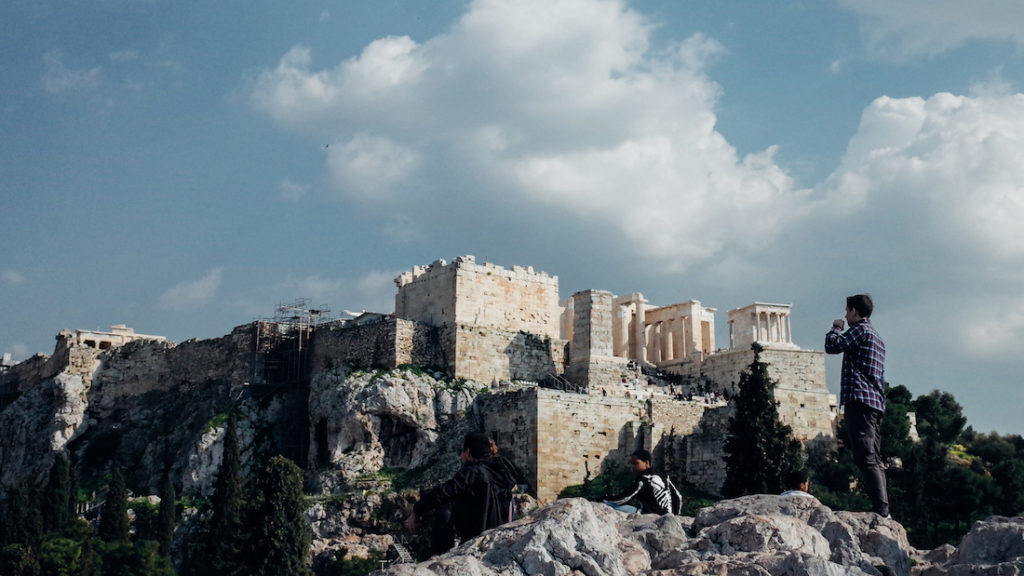
So, after spending three days in Athens, it’s time to leave the capital behind and explore what Greece has to offer. On the Cultural Tour, you will see the mainland of Greece, and you will most likely need a car for that. Some selected tour operators offer day trips to these places of interest. You will find links within the text for them too. However, by renting a car, you will travel at your own pace; therefore, I highly recommend renting one.
One week in Greece: Day 4
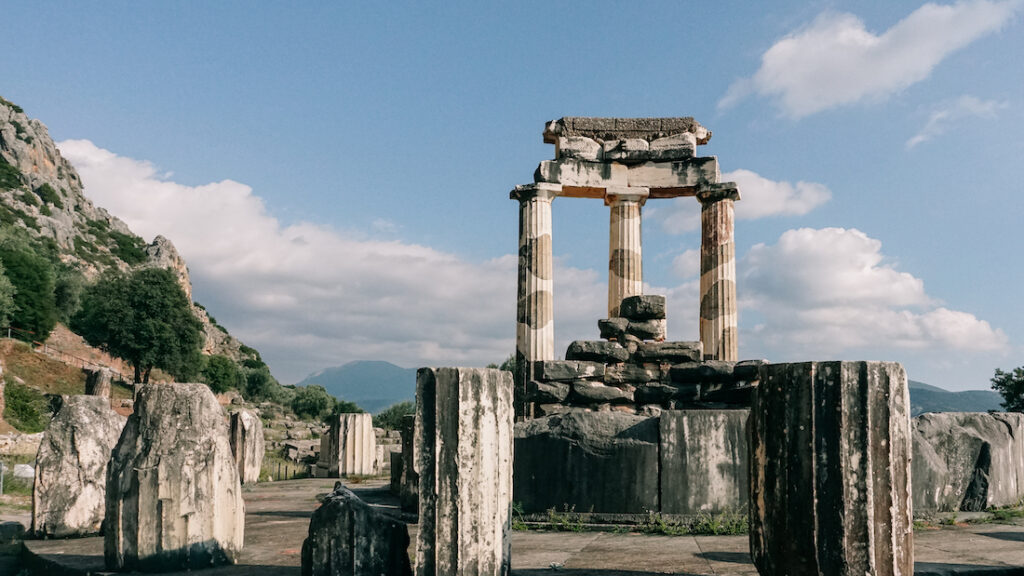
The first day tour on the Cultural itinerary is Delphi. Occupying a part on the southwestern slope of Mount Parnassus, Delphi was considered the center of the world by ancient Greeks. There was even a stone marking it as such, called the omphalos (the navel). Delphi is also a UNESCO World Heritage Site, and it had a significant influence on Greek antiquity.
Delphi is immortalized as the seat of Pythia, the famous oracle of ancient times. Pythia was the high priestess of the Temple of Apollo in Delphi, and ancient Greeks consulted her for the most critical decisions. Pythia entered into some sort of trance, which drove her into ecstatic speeches; the oracles had to be translated. Ancient sources describe Pythia using laurel to inspire her prophecies. Several alternative plants have been suggested, including cannabis and oleander, among others.
The area is rich in sightseeing, and apart from the Temple of Zeus in Delphi, you can also see the Stoa of Athenians, the ancient theater, and the Stoa of Delphi. As you can easily imagine, Delphi’s archaeological area is one of antiquity’s most famous locations. You can find guided tours at the spot, but you can also pre-book tours, including transfers from (and back to) Athens. There is also a nearby city under the name Delphi, which is a more modern settlement.
Practical info for your visit to Delphi
Delphi is approximately 180 km away from Athens, and you’ll need two and a half hours to reach it. Therefore it is recommended to start early if you want to be back in Athens in the evening.
For more information about opening times and admission fees in Delphi, please click here.
If driving back and forth for 4-5 hours in one day is too much, you can stay one night close to Delphi. You can check your options for accommodation in Delphi here.
Last but not least, you can book a tour from Athens to Delphi and back. I’m adding here three of the best ones. Please note that the private tours to Delphi will pick you up from your accommodation, while the group tour has a meeting point in downtown Athens. So, here is the first private tour to Delphi, and here is the second. For the group tour to Delphi, click here.
I wrote a dedicated travel guide to Delphi if you’d like to know more about the sacred precinct.
One week in Greece: Day 5
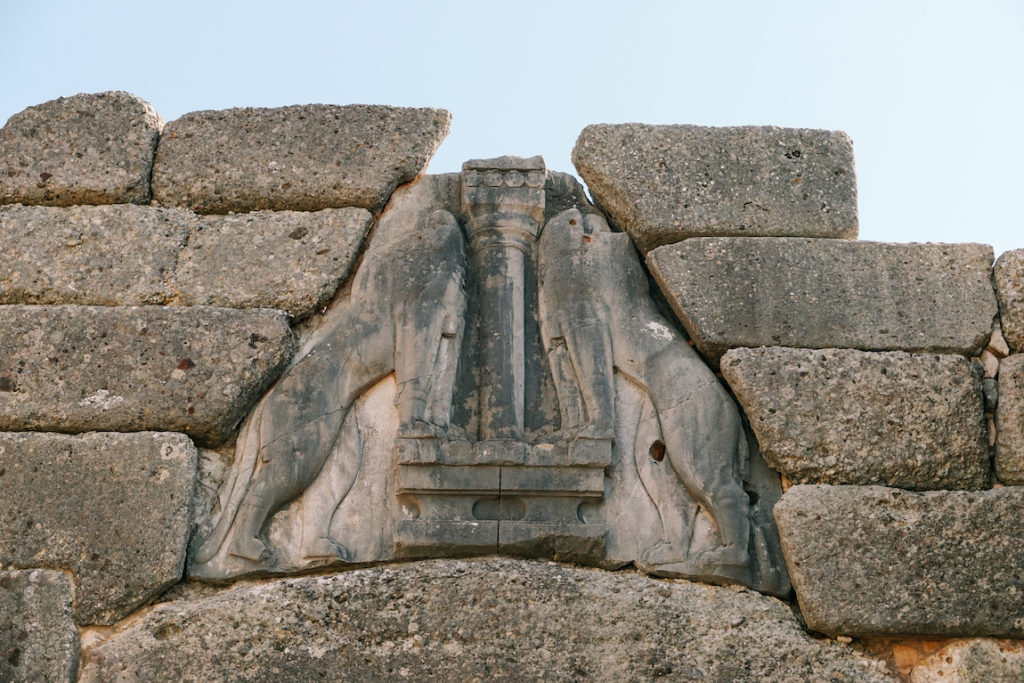
For the fifth day of your tour, I saved the most extended itinerary. By now, you know how Greece looks, and you’ll also be adapted to the roads and the local culture. My suggestion is that you head to Peloponnese, one of mainland Greece’s most beautiful regions. Equally historical with Delphi’s area, the region of Peloponnese is also one of the most celebrated regions of ancient Greece.
The reason for your visit is, of course, Mycenae. Mycenae’s world-famous archaeological site is located about 120 km away from Athens, and you’ll need about one and a half hours to reach it. To get an idea of the importance of Mycenae, the period of Greek history from approx. 1600-1100 BC is called the Mycenaean period.
Mycenae dominated the biggest part of ancient Greece and islands, and at its peak, it had a population of more than 30,000. After visiting Mycenae, you will fully understand the ancient settlement. The area is rich in monuments such as the Treasure of Atreus, the impressive Lions’ Gates, and the Cyclopean Walls.
Continue to Nemea
Just half an hour away from Mycenae lies Nemea. That’s one of the most prominent Greek antiquities spots, where Hercules killed the Nemean Lion. Apart from that, you will also see the Temple of Zeus and the Stadium where the Nemean Games took place. Last but not least, if you are interested in wine, Nemea is a must: Nemean wines are world-famous, and you can visit more than 40 wineries in the region. You can read my guide to Nemea here.
Alternatively, if you are more into castle cities, you can visit Acrocorinth. That’s one of the lesser-known locations of Greek antiquity but an equally important one. Located just a couple of kilometers away from Ancient Corinth, Acrocorinth is a fortified citadel where you can see the famous Peirene spring and enjoy spectacular views of the Gulf of Corinth. The castle city is more than 2,500 years old and extremely well-preserved. You can find more info on my guide to Acrocorinth.
Nafplio and Epidaurus
After a twenty-minute drive from Mycenae, you will reach Nafplio. This is one of the most picturesque Greek towns, located on the coast. It’s very compact, but once upon a time, Nafplio served as the capital of Greece. Wander through the narrow streets of the Old Town of Nafplio, visit the Palamidi Fortress, and see how life unfolds away from the big city.
After having a lunch break, you can drive to the ancient theater of Epidaurus, which is the most well-preserved ancient theater in the world. If you are visiting during the summertime and you are lucky, you might have the chance to watch an ancient tragedy on stage. Despite its age, the ancient theatre of Epidaurus hosts a few plays per year. Book in advance.
Practical information for your visit to Mycenae
A car is very convenient if you would like to visit Mycenae. You can reach the archaeological site in less than 90 minutes from Athens.
You can check the opening times and admission fees for Mycenae here. To check if there’s a play at the ancient theater of Epidaurus, click here.
If you want to stay one night and not squeeze everything in a day tour, you should only consider Nafplio an option. This beautiful town has loads of accommodation options, and it’s a great place to spend a night. You can see your accommodation options in Nafplio here. From my side, I can highly recommend two accommodations in Naflpio, the Hotel Aetoma, and the Leone Guest House.
If you don’t want to drive, some tour operators also offer day trips to the area. Both tours I’m adding here start from Athens and return late in the evening. So, here is the day trip to Mycenae and Epidaurus, and here is the second one, including Nafplio.
One week in Greece: Day 6
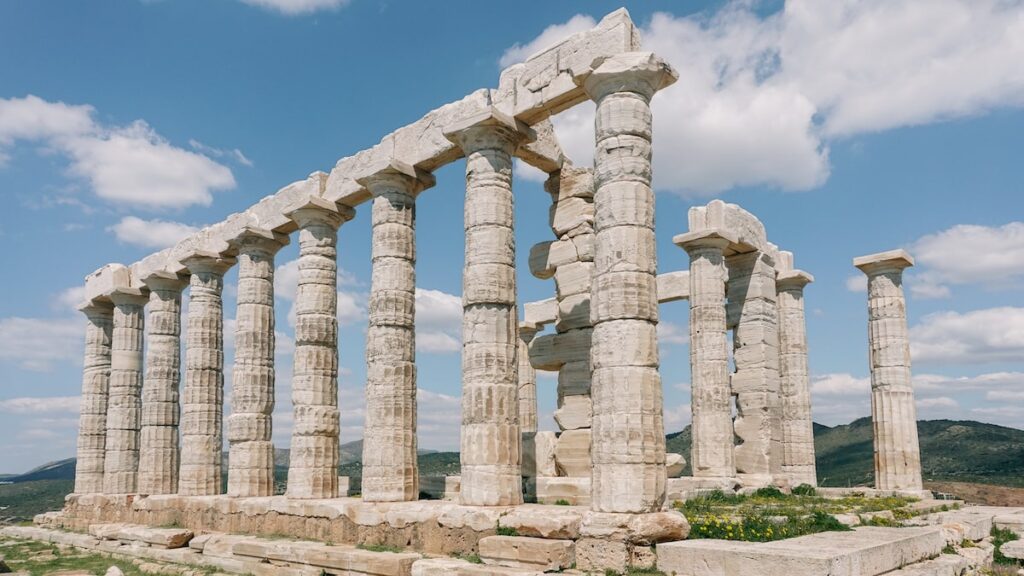
Well, your one week in Greece itinerary might be coming soon to an end, but there is still enough time to explore further. For the last driving day of your Cultural tour, I strongly suggest Cape Sounion. Greeks call it simply Sounio, and it is the southernmost tip of the Attica region. Sounio lies approximately 70 km south of Athens, and you can reach it by car in roughly one hour. You can read my Cape Sounion guide to discover more about this stunning location.
Cape Sounion is famous for the Temple of Poseidon, one of the significant monuments of the Golden Age of Athens. The landscape is majestic: the temple of Poseidon is surrounded on three sides by the sea. As is always the case with Greek temples, the Poseidon temple is rectangular, with a colonnade on all four sides. The temple originally had 36 columns, but only 15 still stand today. The columns are an excellent example of the Doric Order.
Sounio is a very popular daily excursion for the Greeks, and there are numerous beaches around the temple. Quite obviously, of all the sunset spots in the wider Athens area, the one at Cape Sounion is the most breathtaking.
Practical info for your visit to Cape Sounion
For more information, opening times, and admission fees for your visit to Sounio, click here.
There’s no need to stay overnight in Sounio; the archaeological site is well-connected to Athens, and driving there won’t be a problem.
Once again, there are tours to Cape Sounion starting from Athens. You can book a half-day tour to Sounio here.
One week in Greece: Day 7

The last day of your journey will be mainly defined by the time of your departure. If you have a late flight back home, consider having a nice long walk in downtown Athens. Revisit your favorite spot, go again to the cafe you liked the most, and do some shopping. That’s what I usually do on the last day in a foreign city anyway. Or visit that museum you wanted to see but were too lazy the other day.
And that’s it with the Cultural one week tour in Greece itinerary.
One island-hopping week in Greece
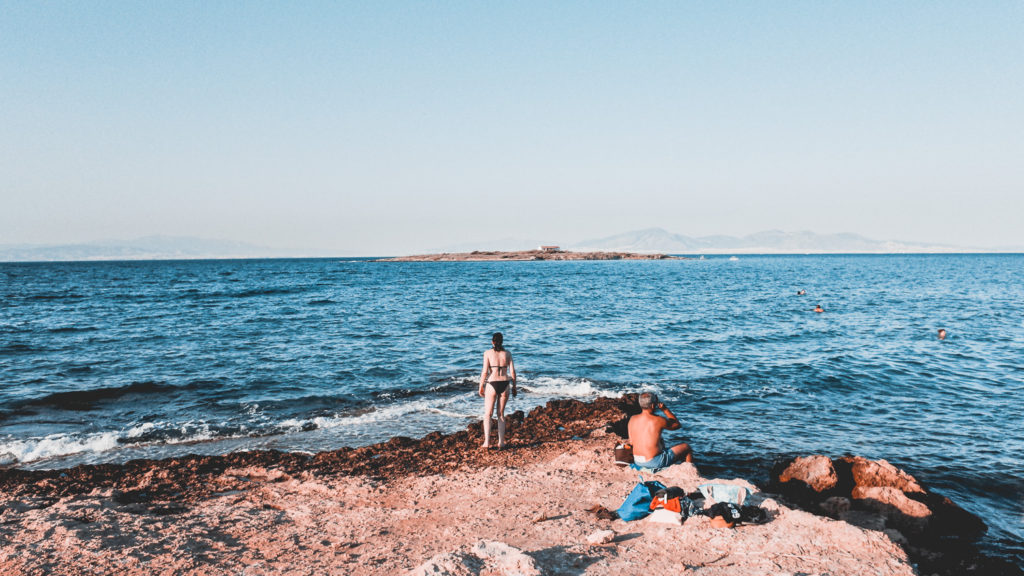
As I stated earlier, the first three days of your tour belong to Athens. Of course, you are the one making the schedule, so feel free to improvise. In this itinerary, I will try to give you an idea of the Greek islands you could visit. Remember that 3-4 days are not enough for proper island hopping. Therefore, you can indeed get a glimpse of the Greek islands. If you are more interested in the islands, I have written a lengthy guide to visiting the Greek islands for three weeks on a budget. But here, I will mainly deal with adding a few wonderful days to your seven-day Greek itinerary.
Unfortunately, in such a short amount of time, you won’t be able to make it to my beloved Anafi. The island is remote and not well served by boats. But there are several other islands to visit, and let’s focus on them here. So, if you have only 3-4 days for the islands, it’s better to visit the ones with an airport. The ferries might need 5-8 hours to reach an island, and if you add another 5-8 hours to return on the sixth day, you can understand that you won’t have so much time there.
As a rule of thumb, do not travel on the last day of your journey back to Athens. The islands are affected by very strong winds, and sometimes, the ferries won’t leave at all (or start with significant delays). No matter what, spend the last day in Athens and avoid losing an expensive flight back home.
The Greek islands to consider
So, which islands to visit in the remaining days of your one-week tour in Greece? Well, the ones that you usually see on the TV or social media do have an airport. That said, you can fly with Aegean Airlines to Santorini and Mykonos, as well as Paros, Milos, and Naxos. Apart from Milos, which the Greeks assume as a couples’ destination, the other four islands mentioned above tend to be crowded. Of course, you can visit just one of them and spend all your days there.
So, let’s see your options.
- Santorini and Mykonos. Get an early flight to Santorini and explore the island all day long. I have written various Santorini guides: here you can find some great boat tours while here you can read about Santorini photo tours. Enjoy Fira, Firostefani, and Oia. Stay overnight in Santorini and explore more of it the following day. On day 5, get the ferry midday to Mykonos. Explore on the second half of your fifth day the island of Mykonos. This is a very famous island and of course an expensive one. Spend the sixth day in Mykonos and get an evening flight back to Athens. Exactly like on the Cultural tour, spend the last day of your journey in Athens.
- Paros and Naxos. Exactly like above, fly to Paros early on the morning of your fourth day and spend it in Paros. Midday the fifth day, get a ferry to Naxos. Spend the rest of the fifth day in Naxos, and return late the sixth day back to Athens. Spend the last day in Athens.
- Saronic Gulf. Athens has the privilege to have several islands nearby, but these are not the most iconic ones. However, they offer a glimpse of the islands’ life, and some are beautiful. You can visit Aegina, Poros, Hydra, and Spetses. I have written extensively about Aegina, but my favorite one is Hydra. There are also daily tours from Athens combining the Saronic Gulf islands, and if you’d like to step foot in each one of them, it’s a good option. You can book an island-hopping tour in the Saronic islands here or also here.
- Consider spending all your days in one of the islands instead of doing island-hopping. Apart from the ones I mentioned above, one excellent option is Astypalaia (read my Astypalaia travelogue here). And yes, you can reach Astypalaia by airplane.
As you can see, one week in Greece is not enough to see lots of islands. On the contrary, you should focus on visiting one or two at the most. The best island-hopping option from Athens is the Saronic Gulf tour. Even if you cut down one day from Athens, there’s still not so much time to visit more islands; therefore, try to enjoy the time in one or a maximum of two islands and come back soon 🙂
Are you interested in island-hopping in Greece? If so, check out my ebook about the Cyclades.
Book your ferry tickets here
A combo tour in Greece

Apparently, the combo tour week in Greece combines parts of the itineraries mentioned above. It’s not so easy to leave something out of the tours, but the truth is that you can’t fit everything in your itinerary. Even if you decide to skip Athens completely, which is something I don’t recommend, there might not be enough time for everything. So, in this part, it comes down to your personal preferences. I will try to add two extra combo-tour itineraries here but feel free to improvise.
- If you are more of a cultural type but would still like to get a glimpse of the islands, Visit Mycenae and tour the Ancient Theater of Epidaurus. Combine it with island-hopping in the Saronic Gulf. If there is still enough time, consider visiting Delphi. Although Cape Sounion is a beautiful place, you could reach it the next time you are in Athens.
- On the other hand, if you are more into island-hopping, you would still like to see some Greek antiquity areas: Skip a day from your Athens stay. Take the airplane to Santorini. Spend two days (Day 3 and 4) there. Fly back to Athens late on your fourth evening and take the Saronic Gulf tour on day 5. Save the sixth day either for Delphi or Cape Sounion. You will get a good impression of the islands, and at Cape Sounion, you will also see the Temple of Poseidon.
Other alternatives for your 1 week in Greece itinerary

I’m adding here two extra options for your vacation in Greece. This is actually a short note and less of a concrete itinerary. I know that some of you might have no interest in Athens, while others might not want to deal with mass tourism in the Greek islands. So, what you’ll read in the following lines is my recommendation to stay either one week in Athens or spend exclusively one week in the Greek islands.
1 week in Athens
If you would like to stay for an entire week in Athens, I recommend following the itinerary I mentioned above at a slower pace. The reason is that Athens is a big city, and moving from place to place can be tiring. Give yourself some time to immerse yourself in the local rhythms and break the itinerary into smaller pieces. For example, visit the Parthenon and save a visit to the Acropolis Museum for the next day. Give yourself some time to digest everything, and don’t just consume the places. Still, I would recommend the day trip to the Saronic Gulf islands to better understand the region.
1 week in the Greek islands
Exactly like with the One Week in Athens section, you can always spend an entire week in the Greek islands. If that’s the case, you can get a corresponding flight straight after your arrival. Mykonos, Santorini, Paros, Naxos, etc., are served daily by Aegean Airlines.
Instead of staying a night on every island, consider staying two. Keep an eye on your budget, and if you have some more time, check if you can stay a bit longer in the islands. Smaller islands are always nicer and cozier, so consider Donousa, Schinoussa, or Amorgos for a laid-back and original Greek vacation.
I have written a comprehensive guide on spending three weeks in the Greek islands for less than 1,000 euros. Read it and get some extra ideas for your trip to Greece.
FAQ about your one week holiday in Greece
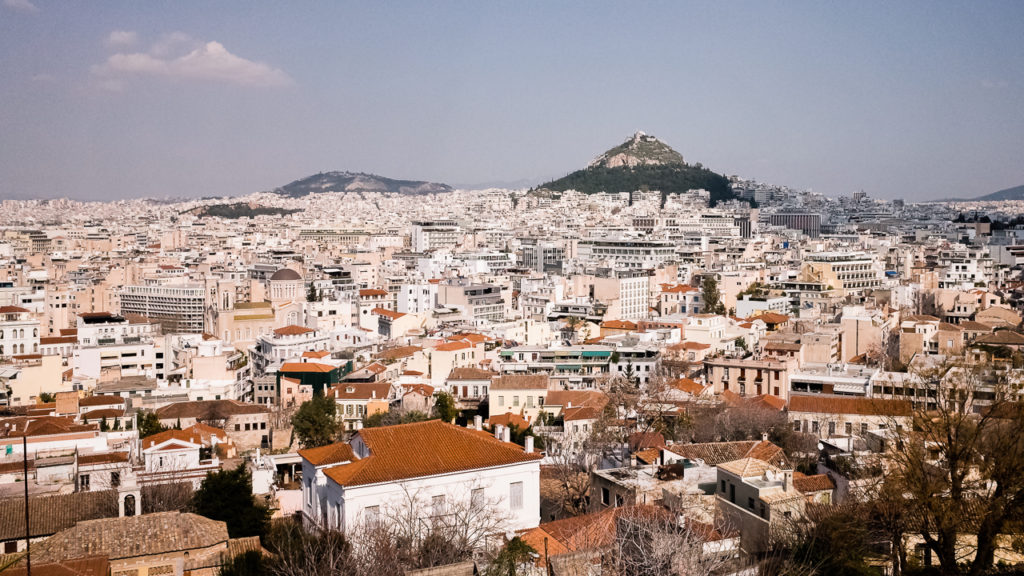
I tried to answer the questions that people usually ask me when it comes to their holidays in Greece. However, if you have more questions, please add them in the comments below, and I will then update this section.
How warm is Greece in July and August?
Greece in July and August can be insanely warm. It’s the time of heatwaves, and if you are not used to it, you might feel exhausted. But this is nothing to worry about: if you follow some basic instructions and protect yourself during the day, you can enjoy your stay. During July and August, you will most likely have hot days, with temperatures above 35 C. Sometimes, it will be even warmer, with temperatures over 40 C, but this lasts just for a couple of days in a row.
Therefore, don’t expose yourself directly to sunlight between 12 p.m. and 4 p.m., and use sunscreen. Also, avoid physical activities. Drink a lot of water and have light meals. You will be fine if you use common sense.
How about Greece in April and May?
Enjoying Greece in April and May is a far more pleasant experience. The temperatures are significantly lower than in July, and you can expect occasional rains. The sea, however, is still cold, and it might not be enjoyable to swim. For sightseeing, though, this is the best time to go on a road trip to the mainland. Or to spend several days in Athens.
So, when it’s the best time to visit Greece?
If you would like to enjoy warm weather and avoid mass tourism, the best time to visit Greece is June and September. The prices are usually lower, fewer people visit Greece, and the weather is still enjoyable without being hot. May and October are equally good months to visit Greece but keep in mind that they can be rainy.
How should I enrich my stay if I have 10 days in Greece?
You can, of course, extend the itineraries that I’ve already suggested. I wouldn’t add anything more to them; instead, I would combine them. If you are traveling to Greece for the “Cultural” itinerary, then try to visit some islands. Or, if you are here for the islands, add some visits to places like Delphi or Mycenae. In general, the above itineraries work even better for more extended stays because they will also let you have some free time. Remember: traveling slowly is a blessing, not a loss of time.
And how about if I have two weeks in Greece?
If you have two weeks in Greece, split the itineraries further. Spend up to five days in Athens and almost a week on the islands. Then, save the two last nights for Athens and take a tour of a place of archaeological interest.
Is Greece cheap?
That’s one of the most frequently asked questions of all time, I guess. Greece is not the cheapest destination, and the islands tend to be more on the steep side. But this doesn’t mean that you can’t have an affordable stay in Greece. On the contrary, you can have a wonderful week in Greece without spending too much. It all depends on your style of traveling. For example, eating at a restaurant might cost 15-20 euros per person, but if you decide to eat souvlaki, it costs less than 3 euros.
So what will be the cost for one week in Greece?

This will depend mainly on what you are willing to do during your stay, but I will try to give you an idea. If I were about to travel to country X, I would choose a hotel for my stay and not a hostel. I usually have a light snack for food, and I eat properly once in the evening. Since I don’t know when I could revisit the X destination, I would go to everything that interests me: landmarks, museums, etc. I won’t spend money on alcohol more than once every two days. And I’d buy a souvenir made in X country to help the local economy. I’d walk a lot, and I’d use public transport.
For all these things, I’d calculate approximately 120 euros per day for Greece. The 120 euros include everything: accommodation (60-70 euros), snacks and water for lunch (10 euros), museums, etc. (10 euros*), and a proper meal in the evening (25 euros). For a week, you can have an all-inclusive holiday in Greece for 800-1000 euros plus your flight cost.
Obviously, if you stay in a hostel instead of a hotel, you can save money by spending 10 euros per night on a bed in a dormitory. Or, if you eat at home every single night, you can also save money. For me, hostel days are a thing of the past, and I always enjoy eating local food. But if you like hostels or you enjoy cooking during your vacation in Greece, your stay can be significantly cheaper.
Two notes on how to budget
1) I added 10 euros per day for museums, and this might be a bit too much; consider, therefore, that this cost also includes some local souvenirs or public transport tickets. 2) If you collect airline miles, consider spending them if you are traveling to Greece from far away. I didn’t add the cost of the flights because it varies: flying from South America to Greece will be significantly more expensive than traveling from London to Athens.
Can you drink the tap water in Greece?
You can definitely drink the tap water in Athens. It’s purified and therefore drinkable, and you won’t have any problems with it. However, if you are worried about drinking tap water when abroad, you can buy mineral water bottles from the local supermarkets or kiosks, the so-called periptero in Greece. Bottled water is valorized in Greece, which means that you won’t have to pay more than 50 cents for the 0,5 l bottle and 1 euro for the bigger bottles.
While the water in Athens is drinkable, you will have to buy bottled water in most Greek islands. The water quality in the islands is fine for brushing your teeth or taking a shower, but it’s better not to drink it. It has a very strong taste, and you’ll have to buy bottles from the supermarket.
One Week in Greece Itineraries: Final Thoughts
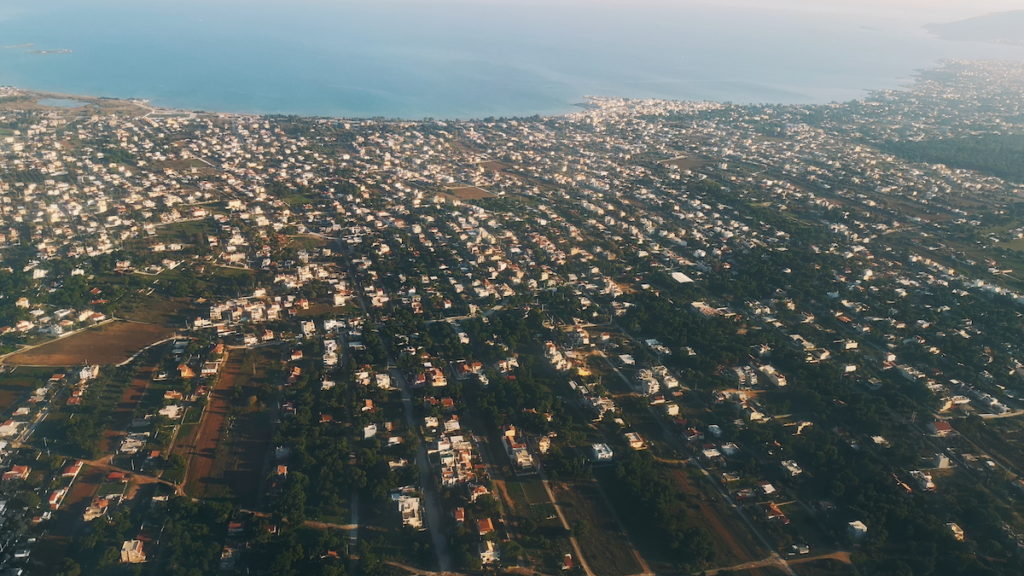
I always advise people to travel slowly and not consume places. You should enjoy the places instead and immerse yourself in the local culture. Rushing from island A to island B or rushing through Athens might exhaust you. On the other hand, Greece is one of these places where slow pace matters. The Greeks even have an expression when it comes to doing things: siga, siga. It translates to slowly, slowly, and this is a lifestyle attitude. If I were you, I would travel slowly around the country. You might not see everything, but you will enjoy your time more.
One week in Greece might not be enough, but it’s an adequate amount of time to make the most of it. Athens, the beautiful Greek islands, the antiquity—all these things will fascinate you. Do it like the locals: slowly. And enjoy Greece as much as you can: it’s a lifetime journey, and you should treat it like that.
Inspiration & tips: Greek ferries guide, 40 travel quotes about Greece, 10 travel tips for Greece
More Greek destinations: Schinoussa, Sikinos, Anafi, Donoussa, Crete, Astypalaia, Santorini
Pin it for later
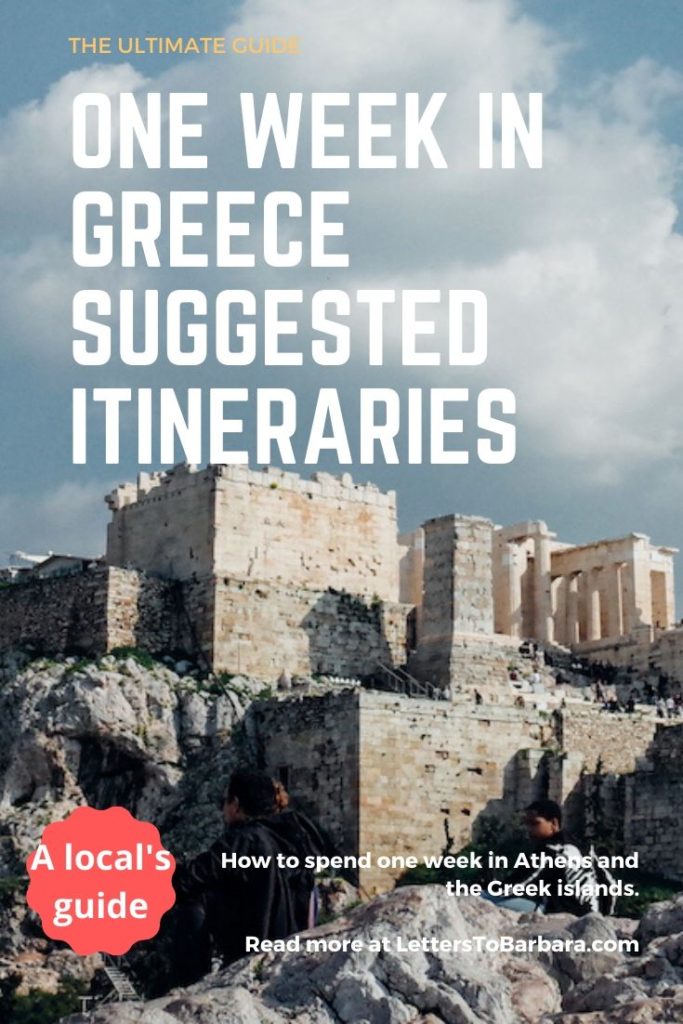
Sharing is caring. Please share this 1 week in Greece travel guide with your friends.
Last Updated on April 5, 2024 by George Pavlopoulos

